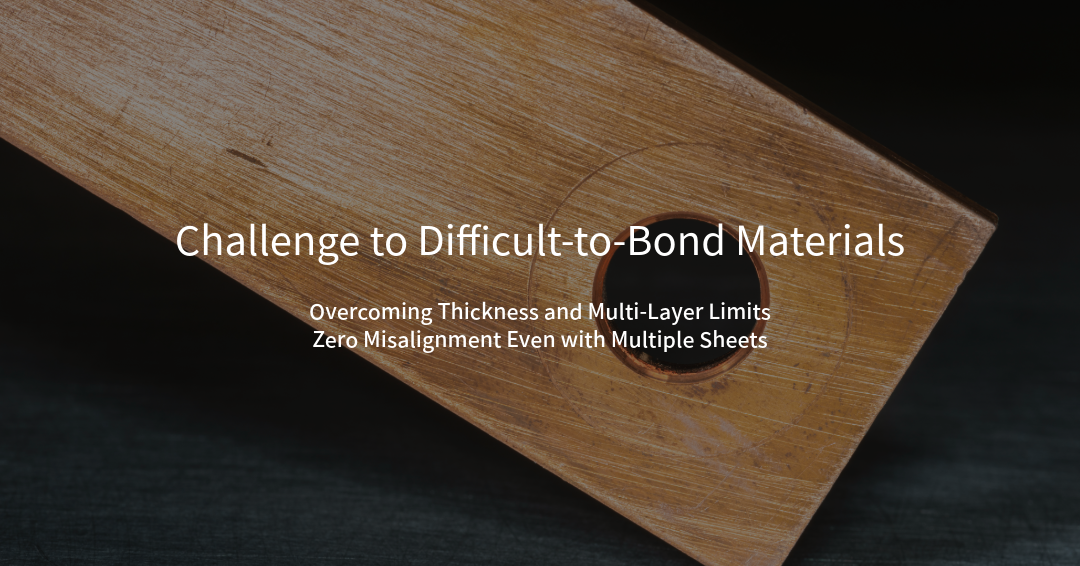Joining thick metal plates and multi-layered materials is essential in the manufacturing of automotive body structures, industrial machinery, and power equipment. It is common practice to stack and bond multiple plates, sometimes several millimeters thick, to ensure strength and high current transmission. However, this thick plate bonding has been a major barrier for conventional technologies.
Laser and arc welding require high-power heat sources to penetrate thick plates, inevitably leading to thermal distortion, residual stress, and degradation of material properties. Furthermore, attempting to bond multiple thick plates simultaneously often results in misalignment and non-uniform penetration, making it difficult to stabilize quality.
LINK-US’s Ultrasonic Complex vibration Bonding (USCB) breaks through this "thickness and multi-layer limit," setting a new standard for single-pass bonding of thick plates with low heat and low energy.
table of contents
Conventional Challenges in Thick Plate Bonding
When bonding thick plates or multi-layered materials, manufacturers face the following issues:
- Need for High-Output Heat Source: Requires immense heat to penetrate the thickness, leading to distortion and residual stress.
- Layer Misalignment: Stacking multiple layers is prone to misalignment due to thermal deformation.
- Non-Uniform Bonding: It is common for the top layer to be strongly joined while the bottom layer remains unbonded.
- Increased Time and Cost: Requires multiple welding passes or additional complex jigs.
These factors have caused low yield rates and increased costs in the manufacturing of large structures and power equipment.
LINK-US Solution: Single-Pass Multi-Layer Simultaneous Bonding
USCB applies ultrasonic complex vibration to the joint interface, achieving atomic-level solid-state bonding by inducing plastic flow between the thick plates. Because the material is not melted, high strength is ensured while suppressing thermal distortion and residual stress.
Notably, USCB enables the simultaneous bonding of multiple thick plates in a single pass. LINK-US’s proprietary fixture design technology transmits force and vibration uniformly, preventing layer misalignment and allowing multiple layers to be joined at once.
The results:
- Low Thermal Impact: Bonding occurs while retaining the material’s mechanical properties.
- Multi-Layer Simultaneous Bonding: Shortens the process and improves yield.
- High-Strength Bonding: Superior fatigue properties due to the absence of melting.
- Zero Misalignment: High-precision fixture design ensures dimensional accuracy.
Application Examples
- Automotive Chassis Components: Simultaneous bonding of multiple high-strength steel plates. Contributes to EV body design by achieving both light weight and high strength.
- Power Busbars: Simultaneous bonding of multiple thick Cu plates. Achieves high-current capacity and low resistance, also improving cooling efficiency.
- Industrial Machinery Parts: Single-pass bonding of multi-layered thick metal structures drastically shortens manufacturing time. Balances durability with cost reduction.
Effects and Benefits
- Process Reduction: Eliminates the need for multiple passes, completing the job in a single pass. Improves production line efficiency.
- Improved Yield: Suppresses layer misalignment and unbonded areas. Reduces defect rates.
- Cost Reduction: Shorter process time and defect reduction compress mass production costs.
- Enhanced Performance: Low residual stress improves long-term durability and fatigue life.
Future Outlook
The EV and renewable energy sectors will see an increasing demand for thick-plate structures requiring high current and high strength—such as busbars in EV charging stations, power converters in renewable energy facilities, and structural materials for rail and aerospace.
LINK-US’s Ultrasonic Complex Vibration Bonding introduces a new standard: "Single-pass, zero-misalignment bonding, even for thick, multi-layered materials," bringing a major innovation to the manufacturing floor.
Summary
Bonding thick plates and multi-layered materials was considered a "limit" for conventional thermal fusion technologies. LINK-US's Ultrasonic Complex Vibration Bonding allows for single-pass bonding of thick plates with low heat and low energy, achieving high-quality bonding without misalignment, even for multiple layers simultaneously.
→ For improving the efficiency and reliability of thick plate and multi-layer bonding, please contact LINK-US.

